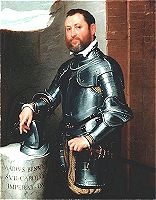 click to enlarge |
PORTRAIT OF MARIO BENVENUTIGiovanni Battista Moroni SN 106, oil on canvas, c. 1560 From: "The Pages"
|
ARTIST:
Born near Albino, just outside of Bergamo, Giovanni Battista Moroni trained in Brescia with the painter Moretto from 1532 to 1553. He returned to live in Bergamo after 1553, remaining there until his death in 1578.
A provincial painter, Moroni seems to have devoted his talents principally to portraiture. According to Moroni’s 1st biographer, Carlo Ridolfi, writing in 1648, Moroni’s skill as a portraitist was highly esteemed by his contemporaries. The painter Titian supposedly recommended to Venetian officials traveling to Bergamo that they have their portraits painted by Moroni because of the naturalism of his style. He also received commissions for religious paintings.
SUBJECT:
It was through the work (in 1981) of an Italian historian, Alberto Belotti, that the Museum was finally able to uncover the life of the sitter, who lived more than 400 years ago. Mario was born in the Northern Italian town of Crema in 1521, the son of Agostino Benvenuti & Ginevra Martinengo.
Following the example of his older brother, Ettore, Mario enlisted in military service under the Holy Roman Emperor, Charles V. Mario fought against both the Protestant princes of the Schmalkaldic League in Germany in the battle of Muhlberg (1547), and the French troops in the war in Piedmont (1551-1555). In 1556, Charles V abdicated; Mario, who had attained the rank of captain, probably gave up his military career at that time.
His family, among the richest & most influential in Crema, was also notorious for acts of violence & evil deeds. In 1537, e.g., brother Ettore killed 2 adversaries in one year; at the same time, their father, Agostino, was imprisoned in a Venetian jail. Ettore died a violent death in 1574, as did his son Maurizio, whose life had been equally wicked. It is not surprising, therefore, that Mario preferred to retire at first to Crema, rather than Bergamo where the family reputation was not good.
However, documents show that Mario married Margherita Bonareni, a widow from Bergamo, & took over various properties of hers. He lived prosperously in Bergamo with his wife & 2 daughters, Nostra & Arpalice, until his death in 1596.
PAINTING:
The painting can be dated around 1560. The equestrian half-armor Mario wears is of a type common at that time. In ¾-length portrait, Benvenuti stands against a background of ruins. Perhaps Moroni intended the ruins to be seen in contrast to the endurance of the captain. There is a palm branch, symbol of victory, behind the broken column on which is inscribed the name of the sitter. Mario’s stance is relaxed, his gaze direct. Beneath the armor are elegant garments indicating his affluent life style, yet in no way diminishing his image as a military officer.